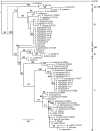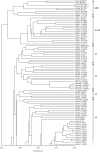A study of the relationships of cultivated peanut (Arachis hypogaea) and its most closely related wild species using intron sequences and microsatellite markers
- PMID:23131301
- PMCID: PMC3523650
- DOI: 10.1093/aob/mcs237
A study of the relationships of cultivated peanut (Arachis hypogaea) and its most closely related wild species using intron sequences and microsatellite markers
Abstract
Background and aims: The genus Arachis contains 80 described species. Section Arachis is of particular interest because it includes cultivated peanut, an allotetraploid, and closely related wild species, most of which are diploids. This study aimed to analyse the genetic relationships of multiple accessions of section Arachis species using two complementary methods. Microsatellites allowed the analysis of inter- and intraspecific variability. Intron sequences from single-copy genes allowed phylogenetic analysis including the separation of the allotetraploid genome components.
Methods: Intron sequences and microsatellite markers were used to reconstruct phylogenetic relationships in section Arachis through maximum parsimony and genetic distance analyses.
Key results: Although high intraspecific variability was evident, there was good support for most species. However, some problems were revealed, notably a probable polyphyletic origin for A. kuhlmannii. The validity of the genome groups was well supported. The F, K and D genomes grouped close to the A genome group. The 2n = 18 species grouped closer to the B genome group. The phylogenetic tree based on the intron data strongly indicated that A. duranensis and A. ipaënsis are the ancestors of A. hypogaea and A. monticola. Intron nucleotide substitutions allowed the ages of divergences of the main genome groups to be estimated at a relatively recent 2·3-2·9 million years ago. This age and the number of species described indicate a much higher speciation rate for section Arachis than for legumes in general.
Conclusions: The analyses revealed relationships between the species and genome groups and showed a generally high level of intraspecific genetic diversity. The improved knowledge of species relationships should facilitate the utilization of wild species for peanut improvement. The estimates of speciation rates in section Arachis are high, but not unprecedented. We suggest these high rates may be linked to the peculiar reproductive biology of Arachis.
Figures



References
- Baldwin B, Sanderson M, Porter J, Wojciechowski M, Campbell C, Donoghue M. The ITS region of nuclear ribosomal DNA: a valuable source of evidence on angiosperm phylogeny. Annals of the Missouri Botanical Garden. 1995;82:247–277.
- Barkley NA, Dean RE, Pittman RN, Wang ML, Holbrook CC, Pederson GA. Genetic diversity of cultivated and wild-type peanuts evaluated with M13-tailed SSR markers and sequencing. Genetic Research. 2007;89:93–106. - PubMed
- Bechara M, Moretzsohn MC, Palmieri D, et al. Phylogenetic relationships in genus Arachis based on ITS and 5·8S rDNA sequences. BMC Plant Biology. 2010;10(255)http://dx.doi.org/10.1186/1471-2229-10-255 . - PMC - PubMed
- Bertioli D, Moretzsohn M, Madsen L, et al. An analysis of synteny of Arachis with Lotus and Medicago sheds new light on the structure, stability and evolution of legume genomes. BMC Genomics. 2009;10(45)http://dx.doi.org/10.1186/1471-2164-10-45 . - PMC - PubMed
Publication types
MeSH terms
Substances
LinkOut - more resources
Full Text Sources
Other Literature Sources
